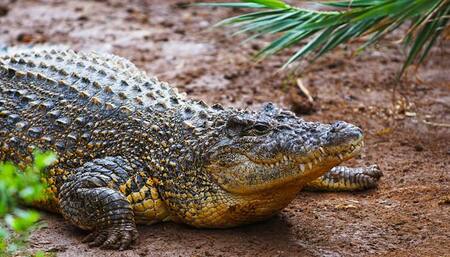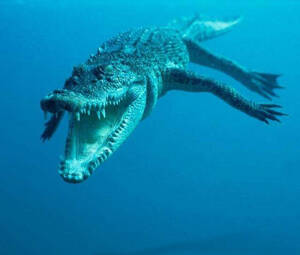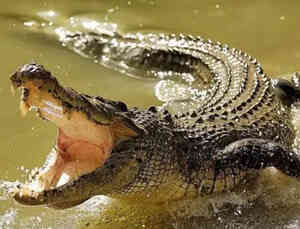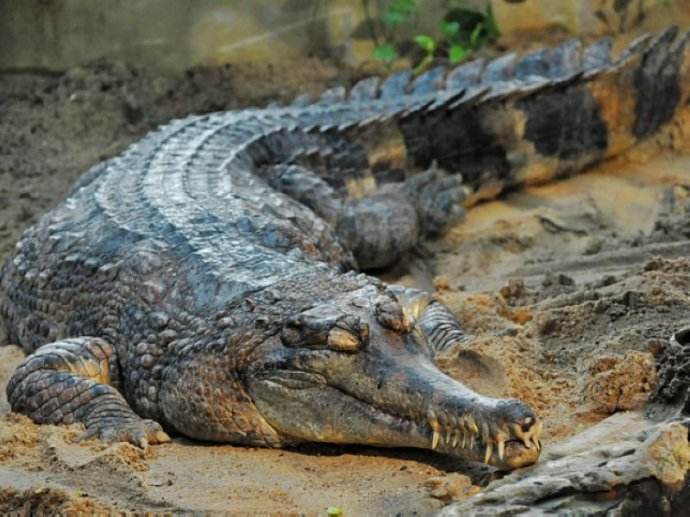Crocodylus porosus
IUCN
LCBasic Information
Scientific classification
- name:Crocodylus porosus
- Scientific Name:Estuarine Crocodile,Salt-water Crocodile,Sea crocodile, saltwater crocodile, hoole, man-eating crocodile, estuarine crocodile, Malayan crocodile, naked neck crocodile
- Outline:Crocodilia
- Family:Crocodilia Crocodylidae Crocodylus
Vital signs
- length:2.5-7 meters
- Weight:600-1000kg
- lifetime:80-100 years
Feature
It is the largest reptile in the world and also the animal with the strongest bite force, which can reach 1905KG.
Distribution and Habitat
Distribution: Australia, Bangladesh, Brunei Darussalam, Cambodia, India, Indonesia, Malaysia, Myanmar, Palau, Papua New Guinea, Philippines, Solomon Islands, Sri Lanka, Vanuatu, Vietnam.
Extinct: Singapore.
Possibly extinct: Thailand.
Saltwater crocodiles live in bays or across the ocean. Saltwater crocodiles live by the water, making their homes in mud nests near lakes or rivers. In addition, male saltwater crocodiles will carefully select a territory for themselves, which takes into account not only the supply of food, places to bask in the sun, etc., but also whether there are convenient paths to approach the opposite sex.
Appearance
The saltwater crocodile is the largest of the 23 crocodile species and the largest reptile in the world. The adult male saltwater crocodile generally does not exceed 5 meters in length, and some can reach 7 meters. The maximum length of females is 2.5-3 meters. Adult male crocodiles can weigh up to 600-1000 kilograms. Juveniles are light brown with black spots and stripes on the body and tail. Adults are darker in color, with a light yellow or white belly and a gray tail at the bottom end. Records show that the largest saltwater crocodile in the world is 7 meters long. The saltwater crocodile has 16-19 teeth on each side of the upper jaw and 14-15 teeth on each side of the lower jaw. Since the saltwater crocodile is the only crocodile in the order Crocodilia that does not have large scales on the back of its neck, it is also called a "naked neck crocodile."
Like other crocodiles, the saltwater crocodile belongs to the dinosaur family. From appearing on Earth more than 200
Details
Saltwater crocodile (scientific name: Crocodylus porosus) is also known as Estuarine Crocodile and Salt-water Crocodile in foreign languages. It has no subspecies. The epithet “Porosus” means “porous”. Since the saltwater crocodile is the only crocodile in the order Crocodilia that does not have large scales on its neck and back, it is also called the "naked neck crocodile" or "naked shoulder crocodile".
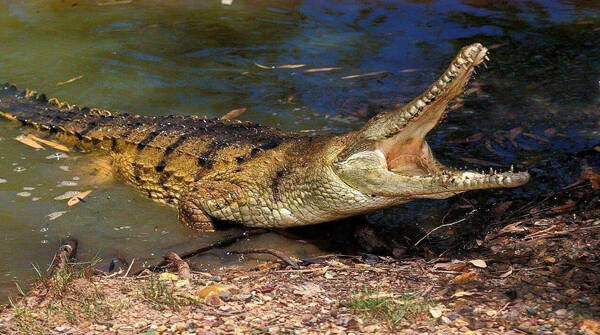
The saltwater crocodile is a large crocodile with a ferocious personality. It has a strong sense of territory. It also has outstanding endurance and can swim from Australia across more than a thousand kilometers of ocean all the way to the Bay of Bengal. It has a physiological structure that adapts to high-salinity water. Saltwater crocodiles are at the top of the wetland food chain, and in some areas they are even more terrifying than tigers. Juveniles prey mainly on insects, amphibians, crustaceans, small reptiles and fish, while adults prey on larger animals, but mainly mud crabs, turtles, monitor lizards and water birds. Some larger adults even prey on buffaloes, livestock, wild boars and monkeys, and sharks in the sea. In Australia, saltwater crocodiles have been recorded as cannibals and even attacking ships, so they are also called "man-eating crocodiles."
Saltwater crocodiles have a strong sense of territory. Male crocodiles monopolize their territory and drive out intruders. One male leads a group of females. Adult crocodiles are often underwater, with only their eyes and noses exposed above the water. They have sensitive ears and eyes and sink immediately when frightened. In the afternoon, they often float in the water to bask in the sun. At night, their eyes are as sharp as torches, and the eyes of young crocodiles are red.
The ferocious appearance of the saltwater crocodile when hunting makes it a "cold-blooded killer" in people's eyes. The most deadly weapon of the "killer" is its narrow and long bloody mouth. This big mouth, which occupies one-sixth of the saltwater crocodile's body length, has a great bite force of about 200 kilograms per square centimeter, which is more than 10 times stronger than that of humans. However, the saltwater crocodile's teeth cannot bite and chew food. It often clamps the prey with its big mouth, drags them to the rocks or tree trunks on the water bank, and beats them violently until they are broken or softened, and then eats them bit by bit. Because the saltwater crocodile's teeth cannot chew food, it has a special stomach with the strongest gastric acid among vertebrates. This makes its digestive function very good, and it can digest any food, including bones. Bay crocodiles sometimes eat sand and stones to help them digest.
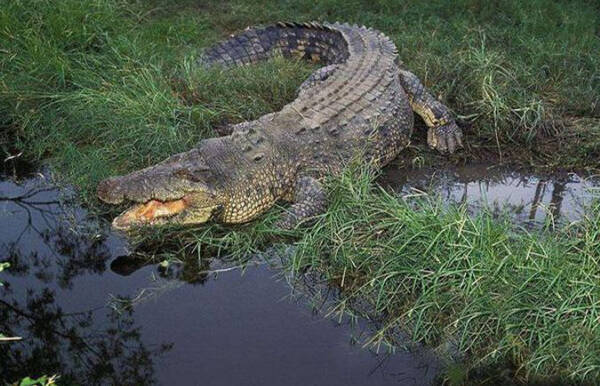
Females reach sexual maturity at about 10-12 years old. Males reach sexual maturity at 16 years old. The mating season for saltwater crocodiles is between May and June, depending on the region: Thai species lay eggs in July and August, and Java species can even lay eggs in February. Male saltwater crocodiles often engage in territorial defense battles during the breeding season. They will first assume a fighting posture and then violently butt each other with their heads. If this tactic doesn't work, they will bite each other with their mouths until their opponent's jaws are bitten off. Of course, the winner will win the right to mate with the female. The male presses his body on the female's back, grabs the female with his forelimbs, and wraps his tail around the female's hindquarters to mate, which can last for several hours.
The saltwater crocodile uses rotten grass to build a nest in the shaded hills by the Tamsui River (more than 60,000 meters from the sea), sweeping out a 7-8 meter platform with its tail. On the platform, a nest with a diameter of 3 meters is built to place crocodile eggs. The nest is about 4 meters away from the river and is shaded by leaves. Each nest contains about 20-90 white calcium-shelled eggs, with a diameter of 80 mm × 55 mm. During the incubation period of the eggs, the mother crocodile will always stay by the nest and sprinkle water on the eggs with her tail from time to time to keep the eggs warm, maintaining a temperature of 30-33℃, and incubating for 75-90 days. The hatchling is 240 mm long, can reach 480 mm in one year, and can reach 1156 mm in three years, and weighs 5.2 kg.
If you are attacked in the water, poke its eyes when it is not paying attention in the chaos; if you are on land, find an opportunity to punch its nose a few times, and it will run away. This is because the nerves in the crocodile's nose are well developed, and once it is hit, it will make the crocodile weak; if you are bitten, it is best to roll with it and then find an opportunity to break free. However, the bite force of the saltwater crocodile is about 1902 kg, which is difficult to break free.
Adult saltwater crocodiles have almost no natural enemies and can hunt large mammals such as tigers and leopards. However, their confrontation with other top predators may result in injury or even death.
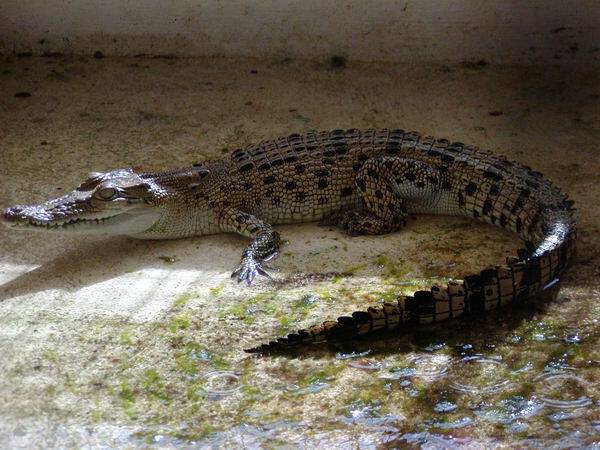
The largest reptile in the world: The saltwater crocodile is the largest of the 23 crocodile species and the largest reptile in the world. The longest length is more than 7 meters and the weight is 1400-1600 kilograms. (Guinness World Records)
The greatest economic value of the saltwater crocodile is its leather, which is one of the most precious leathers in the world. Saltwater crocodile meat is edible, and Burmese people love to eat crocodile meat. Thai people do not love crocodile meat but treasure crocodile gall, which is used to treat infertility in women. Saltwater crocodiles are distributed in a wide area and have a large output. In addition to eating meat, Southeast Asians also use tanned crocodile skin to make leather shoes, belts, boxes, handbags, etc. The patterns and colors are beautiful, and they are precious decorative leather products with high craftsmanship value. As a large reptile, the saltwater crocodile also has great ornamental value and is one of the important resources for developing tourism.
Saltwater crocodiles are large in size, have good-quality hides, and are highly valuable, so many countries in the world raise saltwater crocodiles. Papua New Guinea, Australia, Southeast Asia, and even France, which does not produce crocodiles, have large-scale breeding farms. There were a large number of saltwater crocodiles distributed in southern China during the Tang and Song dynasties, but they became extinct for various reasons. In 1980, Shantou, Guangdong, introduced more than 20 Siamese crocodiles and saltwater crocodiles from Thailand, but they were not successful due to poor breeding and management. In the 1970s, Guangdong Province and Hainan Province successively established 5 breeding farms, and most of the breeding farms have gained experience in breeding offspring. Currently, the largest scale of saltwater crocodile breeding is recommended in Australia and Thailand.
Wild saltwater crocodiles are protected in most countries, but the effectiveness of protection in some countries is questionable. Internationally recognized as the best protected should be Papua New Guinea and Australia, where wild populations are in a state of sustainable use and growth. A conservation management plan similar to the above two countries is beginning to be tested and implemented in Indonesia. In addition, the number of artificial saltwater crocodiles is increasing significantly, especially in Southeast Asian countries.
Listed in the "Red List of Endangered Species of the World Conservation Union" (IUCN) 1996 ver 2.3-Least Concern (LC).
Listed in Appendix I of the Convention on International Trade in Endangered Species of Wild Fauna and Flora (CITES).
Protect wild animals and eliminate game.
Maintaining ecological balance is everyone's responsibility!

